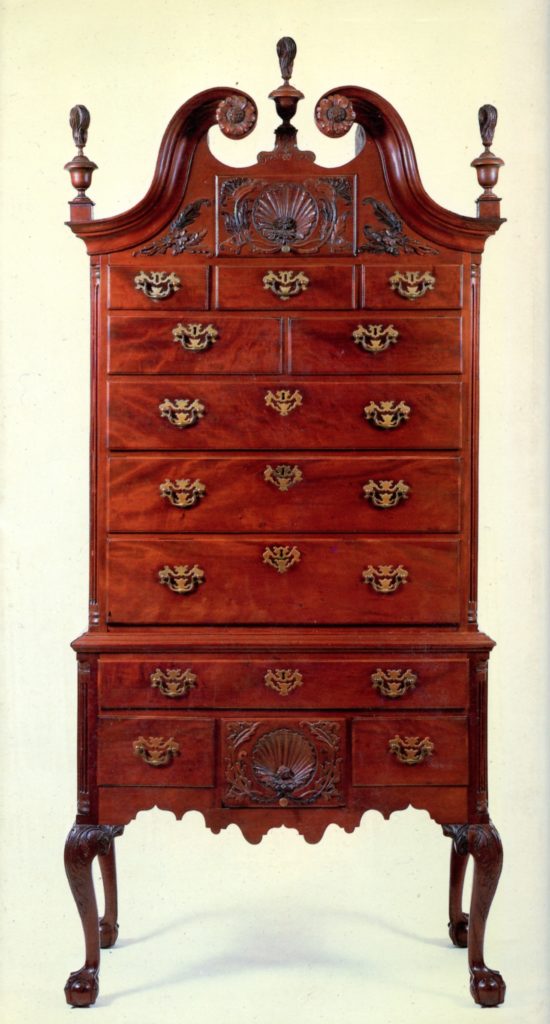We may receive a commission when you use our affiliate links. However, this does not impact our recommendations.

Highboys are magnificent pieces of furniture. This one is not the highboy I discuss below.
I’ll probably get pushback for this post, but I’m posting it anyway.
Three decades ago I had a unique opportunity of being considered for a conservator’s position in the magnificent furniture collection at the Winterthur Museum and Gardens in Wilmington, Delaware. How that came about is another story. Here, I want to relate some of what I came to believe after touring the museum during the interview. (If you ever get the opportunity to tour this museum, don’t pass it up.)
Conservators are tasked with preserving our heritage: buildings, paintings, textiles, furniture, etc. My impression is that there are two large categories of conservators, those who work in museums and those who work for private individuals and companies. These conservators are called “Conservators in Private Practice.” In fact, they have their own sub-group within the conservator’s organization: American Institute for Conservation of Historic & Artistic Works (AIC).
Museum conservators practice a much purer philosophy of minimal “intrusion” and trying to preserve everything original than conservators in private practice who are usually required to make the objects functional. A chair in a museum sits behind a rope and isn’t touched by visitors while a chair in someone’s house is usually sat upon and needs to hold up to this.
The object in the museum that stands out most in my memory is a highboy (not the one pictured). All its joints were lose and it would have fallen apart if not for an elaborate frame that was built for it and attached to its backside. I looked at this piece and really wanted to reglue it so it would be functional.
I mentioned doing repairs like this during my interview and was soundly scolded. This was not something that was even considered at Winterthur. Instead, everything was left as close to the existing condition as possible, and records were kept of everything that actually was done to each piece and filed in a file cabinet. These records would tell future conservators what had been done to the furniture in the collection.
The conflict I had in my interview probably played a role in my not being hired, an outcome for which I have been forever grateful because the position was very prestigious and would have been hard to turn down. I was very happy in my restoration shop regluing loose furniture and replacing parts.
Anyway, this highboy and the record keeping got me thinking. Which is likely to survive longer, a highboy in functional condition or paper records in a file cabinet? As long as the economy flourishes (so Winterthur survives) and as long as catastrophes are avoided (war or environmental, for example), both would probably survive for the foreseeable future.
But, what if something happens that causes the collection fall into the hands of people struggling to survive? Which would be more valuable to them: a file cabinet of records, or a functional highboy (chest-of-drawers)?
I would have reglued the highboy (with hide glue, of course).
Your thoughts can be entered in the box below.
– Bob Flexner
Here are some supplies and tools we find essential in our everyday work around the shop. We may receive a commission from sales referred by our links; however, we have carefully selected these products for their usefulness and quality.









I am in complete agreement with you, Mr. Schwarz
Helmuth
Even though I haven’t seen the Antique Road Show in over 10 years, I always thought it was hilarious when someone brought in a piece with photos of before and after refinishing, and Kelso would say “Oh, too bad, that would have been worth $500,000 if you had left the original scratched, dented, crusted, crazed, dirty finish (which looked like a Jackson Pollock painting), but since you had it refinished it’s now only worth $50.”
That’s obviously an exaggeration, but what I found amusing was just how much better the pieces looked after a well-done, sensitive, period-appropriate refinish job.
I was commissioned to make an exact duplicate set of James & Dolly Madison’s side and arm windsor chairs for the dining room at Montpelior. A lady came to my (then) garage shop with white gloves to hand over the chairs. After she left I must have touched every square inch of those chairs with my bare hands – no harm done.
I live around the corner from Jefferson’s ‘Poplar Forest’. The curatorial staff will not put anything in the amazing octagonal house unless they know with 100% certainty that the item was there originally. Not good enough to have period appropriate pieces to at least make the place look appealing. They prefer spartan empty rooms. It’s bizarre, IMO.
–William F. Brown Fine Furniture
http://www.LineAndBerry.com
I fall into the camp of furniture and tools must be functional and usable. I have a lot of tools from the 1800’s, and I have irreparably damaged them in making them useful to me now. We have purchased antique furniture since we purchased a historic home. I repair it, reupholster it, and reglue it. It must be functional. Now we don’t own historic pieces, and wouldn’t, but have purchase Sharaton and Duncan Phyfe style furniture made in the 1920’s. It is well made, and very usable. I do not use hide glue to repair most of the time. And yes I have again irreparably damaged some furniture. But if I can’t use it, or my family can’t use it, we get rid of it. Except for old clocks and tools, Those I kind of hang onto more than I should.
I think this is one step removed from your “Refinishing considered harmful” letter to Antiques Road Show of a number of years ago. Not that that ever changed their comments on the show, from what I can tell.
The Antiques Road Show often complains about refinishing a piece and decreasing its value. They do sometimes comment on repair work “Done in the past” so long ago that it doesn’t affect the value. After all, the piece was meant to be used and repair is a part of being used. So if you glue and wait long enough to be far “in the past” it will have maintained its value.
Glue it and don’t refinish it, or make the frame so much larger that all the loose pieces can be seen in the exploded view, thus allowing a much greater instructional value. it is all in pieces after all.
My former wife had a simple but nice chest of drawers her family had brought across the states in a covered wagon. Every joint was loose, the drawers so worn it was difficult to close them and the back [solid wood] boards had separated. Just looking at it seemed to make it wobble. Add to all this, it had long since lost its legs, so the bottom drawer sat about an inch off the floor.
The ex was just going to abandon it, history and all, so I rescued it, broke it down, tightened and glued all the joints, replaced broke parts and added legs. Too, I beefed it up so people could do what they shouldn’t drag it around the room.
It now lives with my daughter and is doing well. Had it been treated like a museum piece, which it might have deserved (not all furniture has to be ornate to deserve respect), it would be in a land fill.
For these reasons, I am of the camp which would restore for the history and aesthetics, and for functionality. Either it’s worth looking at and considering or it isn’t. In the end, if a million people look at it, only a few of them will care about principal over restoration. After all, adding a little unseen hide glue, or even carpenters glue, is only going to make a difference if people know and care it happened. Not adding it certainly could detract from the original beauty of the piece and its story.
pardon my red flag for typos but this word is constantly being mis-spelled/mis-used “All its joints were lose” later in the article its the word “loose” is used correctly.
As for glue or no-glue controversy: Conservation is controlled by those in power at the time, they decide what is the correct policy. If a piece is used on a regular basis, of course it should be repaired in the safest, least intrusive manner; if its a museum piece who would know the difference? How many of us would get behind the rope barrier!
I think you would have made an excellent conservator Bob. I stumbled onto your posting via a google alert about museums and had to smile. Though I wasn’t involved in your interview I was at Winterthur finishing my graduate work as a furniture major that year. I know your reputation even 30 years ago was substantial and skill set worthy of application to the collections at Winterthur. What I can say is that your interest in understanding the history, performance characteristics and technical nuance of materials would have found a been well used in furniture conservation.
The recounting of your interview and discussion of the condition and potential treatment of the Philadelphia chest on frame is a wonderful starting point for a discussion about the the “conservation ethics” that drives many decisions in museum collection care. Those components usual involve some combination of each of the following:
Safety of the object.
Preservation of original materials and context.
Allowing the object to communicate original intent as much as possible while respecting the previous two items.
Striving for minimal intervention while achieving these goals.
Of course, more comes in to play at times but that is the gist of what often drives treatment decisions at museums. When functionality plays a more assertive role in the use or interpretation of the object (as in many private collections) then the sliding scale of these factors sometimes shifts the emphasis towards more intervention. Nothing wrong with that. The amazing thing about the field we both enjoy is that we all value the amazing design and historical significance of the furniture we care for and are not shy of sharing insights gains through years of examination and consideration. I know we’ve touched base a few times over the years for just that reason. Historian and technical researcher that you are you would have excelled in that realm as well the path you followed. Both are relevant and complementary. These masterpiece historic furniture survivors are able to communicate more than their function for those curious enough to look closely. Looking from different angles benefits us all.
I’d glue it. It was glued originally and that solution seems less intrusive (to me) than a frame designed to hold it together. (Unless conservation means conserve everything including the failed joints)